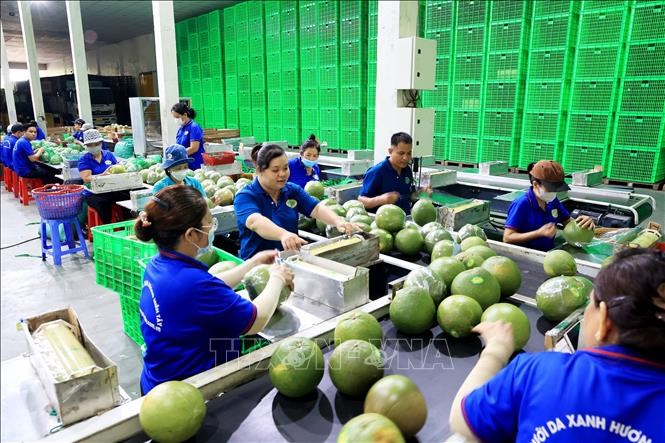Source: Bnews.vn
 Packaging line for green-skinned grapefruit for export at Mien Tay Huong Facility (Phuoc Trung hamlet, Phuoc My Trung commune, Mo Cay Bac district, Ben Tre province). Photo: Hong Dat – VNA
Packaging line for green-skinned grapefruit for export at Mien Tay Huong Facility (Phuoc Trung hamlet, Phuoc My Trung commune, Mo Cay Bac district, Ben Tre province). Photo: Hong Dat – VNA
With the strong explosion in fruit and vegetable export value last year, businesses believe that this is the starting year for Vietnam’s fruit and vegetable exports.
According to the Ministry of Agriculture and Rural Development, thanks to a growth rate of over 70%, fruits and vegetables are one of two products with a record high export value of 5.69 billion USD.
Vietnam’s top fruit and vegetable export markets are: China, the US, Korea, Japan, Thailand, the Netherlands, Australia… In particular, China is still Vietnam’s largest fruit and vegetable import market. and accounts for 65%.
Dominating the “throne” of dragon fruit, durian has become the product with the highest export value with over 2 billion USD. Mr. Nguyen Dinh Tung, General Director of Vina T&T Company, said that after the Protocol on plant quarantine requirements for durian exported from Vietnam to China was signed, the business has exploited a lot. effectively this advantage.
Mr. Nguyen Khac Tien, Chairman of the Board of Directors of Ameii Vietnam Joint Stock Company, said that the main export products are lychee and many types of vegetables, but when durian was opened to China, the business quickly Take advantage of the opportunity to export to this market.
Recently, Ameii Vietnam joined the trade promotion delegation of the Ministry of Agriculture and Rural Development and had access to large Chinese corporations and import enterprises specializing in processed durian products. This also shows that the signal of a well-processed durian market will contribute to increasing the export value of the fruit segment.
With a strong boom in fruit and vegetable export value in 2023, Mr. Nguyen Khac Tien assessed that this is the starting year for Vietnam’s fruit and vegetable exports. Because Vietnam still has a lot of export potential with many products waiting to be opened.
Currently, the North is harvesting winter crops, especially Hai Duong carrot products. Ameii Vietnam Joint Stock Company is focusing strongly on this product group to markets, especially Korea. The carrot products brought by the business were well received and responded to by customers in other countries. Output continuously increases over the years.
For the Chinese market, the opportunity to export fruits and vegetables to China is continuing to expand as recently, the Ministry of Agriculture and Rural Development (Vietnam) and the General Department of Customs (China) have just signed a Decree Letter on plant quarantine requirements for fresh watermelons exported from Vietnam to China. The Protocol is a step to promote the official export of this traditional agricultural product of Vietnam.
Mr. Huynh Tan Dat, Director of the Plant Protection Department, Ministry of Agriculture and Rural Development, shared that the unit has exchanged information with the General Department of Customs of China to provide comments on completing the draft Protocol on Requires import of chili, fresh coconut, frozen durian. At the same time, continue the negotiation process for citrus fruit products and medicinal herbs to this market.
In order for Vietnamese vegetables and fruits to continue to penetrate deeply and widely into markets, Mr. Nguyen Khac Tien believes that it is necessary to improve business management, production processes, coordination in the link chain… industries that have learned the benefits. Lesson learned and next year it may be possible to dominate the market.
As a business that is entering the Japanese market and gradually expanding the Chinese market with products that have signed the protocol, Mr. Nguyen Khac Tien shared that when participating in these markets, Ameii Viet Joint Stock Company Nam will have to perfect the standard production chain. At that time, to bring high quality products to the market, farmers must change and comply with the production process.
“The strategic direction of the business is to develop products with high transparency, so when exporting officially to China, the business must play a clear game,” Mr. Nguyen Khac Tien shared.
The Plant Protection Department said that to date, the unit has coordinated with importing countries to issue 6,997 growing area codes and 1,613 packaging facility codes for export for fresh fruits such as dragon fruit and mango. , star apple, banana, grapefruit, passion fruit, seedless lemon, longan, lychee, chili, black jelly… are allowed to be exported to China, America, Australia, New Zealand, Korea, Japan…
Determining the important role in developing growing areas and packaging facilities for export products, Mr. Huynh Tan Dat said that the unit has actively coordinated with localities to develop and expand the quantity and area. Analyze the growing area code as well as the number of packaging facilities to meet the requirements of the importing country. At the same time, do not neglect supervision so that growing areas and packaging facilities maintain conditions that meet the requirements of the importing country.
The Plant Protection Department continues to remove technical barriers, opening the market for fresh fruits; Carry out export plant inspection and quarantine for exported agricultural products; In particular, focusing on key fruits and key markets such as China, the US, EU…, contributing to maintaining and expanding export markets for Vietnamese agricultural products.
